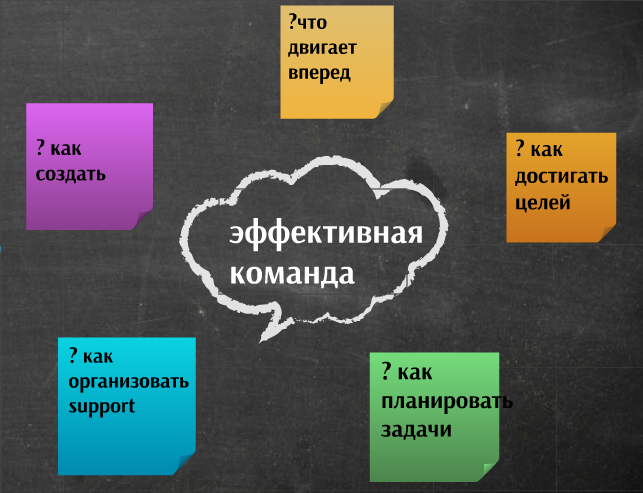Practical advice: how to effectively control employees in the it-department?

We all think about how to open our own business, how to create a successful company or something grand.
I can definitely say that in order to do something big and successful, you need a good team. But how to create such a team? In this article I will try to reveal how we work with our team, and how through joint efforts we achieve good results.
The first thing I want to note is a large set of publications on this topic. Many talk about the fact that there is no ready-made recipe and you need to try. Neither can I disagree with this. It is necessary to experiment and I will say even more, it is necessary to be the first in something, then the synergy of the advanced and effective approach can turn out.
I will not write about how to find the right people. It seems to me that Peter Thiel said it well in one of his books. The bottom line is that we all in the team need “guns”, and not just “bullets”. Since we cannot control everything, there must be people who themselves are ready to perform complex tasks and guide people (“bullets”). Based on this conclusion, I would like to describe how you can build work with “bullets”.
First of all, it is necessary to determine whether your work is a project, and how many distractions in the projects (support support). If we give an example of the company in which I work, then it cannot be called only project work. Projects have already reached a certain maturity and require support, but since we are on the “web” (in the field of high technology), we need to develop. This means: to search for new ways to increase orders on the site, create a single and more technological platform, implement more complex and optimized processes in CRM for the entire business, personalize newsletters and so on. And the question naturally arises, how can one achieve results in the it department in an effective and simple way? The answer to this question is simple: “team”. The team must very clearly understand what task needs to be done immediately, and which one can wait. Many will say that the manager is responsible for this. In my opinion, this is not entirely true.
If we turn to flexible methodologies, we will see a situation where leaders are fading into the background. The team itself decides what to do first and what to leave for later. We can even notice that the developer is not only writing code, but also testing, and sometimes even introducing a new product. And that is not bad. It is important to understand that a team is a living organism, it develops itself, and one who does not want to grow with the body goes by the wayside or even drops out of growth. In my opinion, employees who do not develop or develop in an excellent direction are not needed in the company, they will only pull the whole company down. Such people need to be quickly disposed of.

What moves the team forward? Of course, this is an idea. Each team must very clearly understand what the company has a mission and what it wants to achieve. Therefore, the first thing to do is to designate simple and understandable ideas to the team that all employees will share. A reasonable question arises: how to start the movement, because sometimes an idea is not enough? In this case, meetings help us once or twice a month. Thanks to them, all employees will learn about what results the company wants to achieve, and what needs to be done.
I propose to return to the discussion of the team. After we decided that the team is a living organism that has an idea that makes the whole company move. We must learn to build goals. You can refer to the simple SMART method, you can read about it separately. The main thing is that the goals are clear and achievable to everyone. These goals can be discussed once a week only with your team. It is important that each team member knows what the employee is going to achieve. In order to effectively achieve the goal, we must be limited by something. For example, the iterative approach was very suitable for us. When for a certain period of time (we had it for a week), each employee must show a result that will help to achieve the goal.
It is important to understand that the tasks that lead to the achievement of the result should be clear, even to the baby. Then we can be sure that the result will be at least some. The tasks that lead to this result should be divided into smaller ones (decomposition) and lead to a specific daily result. You can check the result at rallies (daily meetings), where each employee on the SCRUM methodology will give an answer to three simple (and at first very difficult) questions: What have I done from the last meeting to achieve the goal? What problems did I have? What am I going to do today in order to show the result by the end of the iteration?
Usually a meeting consists of a group of no more than 6 people. The meeting should not be delayed for more than 20 minutes. If such a situation arises, less time needs to be devoted to details. It is better to approach the employee separately and help him figure out his current tasks. In our company, each employee of the it-department can ask for help, and this is welcome. Good effect is achieved with pair programming. The tasks that are discussed at the meeting are recorded by the scrum-master for each employee separately in the format: “What has been done:” and “What will be done for the next meeting”. We use Skype chat between the scrum master and the employee, so that these entries are visible to each team member and you can quickly ask about what this task is. So that employees do not get distracted by chats and mails,
- We don’t use mail at all (if we use it, it means we’ll rest from tasks (everyone needs breaks, but it’s better to spend them on tea));
- Disable notifications in skype (command: / alertsoff, use skype to explain the task you are doing, setting an urgent task);
- We use the command / alertson [text] in important Skype chats in order to respond quickly.
- So that it was possible not to use the mail, all calls to the it-department are initially processed by the it-manager. Many tasks at the stage of communication with stakeholders do not turn into tasks.
The tasks that each team employee performs are fixed in the tracker (we use worksection). If the manager or the person who sets the task (Scrum-master, product owner) did not find the time to detail it, then the developer needs to enter its tracker on his own. The team should plan their tasks and know who is responsible for what tasks. For effective planning, we use Google Docs, in which each employee can filter tasks on their own. In my opinion, each member of the team must learn to evaluate their tasks.
In order for the assessment to have a real resonance, it is put opposite each task. Assessment is a score, which includes two signs: it is important for the business and the deadline. Example, if the task is completed in 1 day according to the assessment of the team (and the employee who will perform), then this task weighs 1 point. If the task is very important in order to show the result, then it can be given from 0.1 and above points, at the discretion of the team. This method was taken from the book by Rasmusson J. “Flexible management of IT projects. A Guide for Real Samurai ”and begins to bear fruit only when each team member understands how important these points are for the team. There is a difficulty when each employee will want to get the most points and will not perform other important tasks, for example, related to the support (support of ongoing projects). To avoid such cases, we introduced a specific rule:
“Every morning we check the tracker for new tasks:
- tasks that we can close within 15 minutes, close immediately;
- tasks that we cannot complete within 15 minutes we are discussing at the meeting. ”
This rule made it easy to identify important tasks and give them more points.
As a result, we got full control over our employees, while everyone knows how effective he is and what results the team wants to achieve. In the next article I will try to disclose in more detail our results and the difficulties that we encountered.
